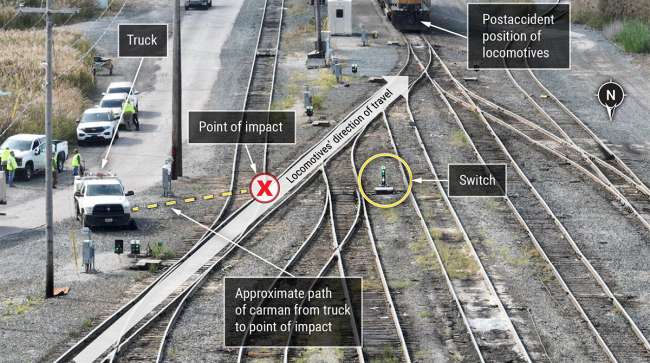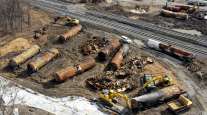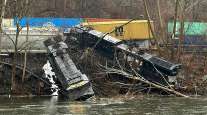NTSB Update Highlights Questions About Remote-Control Trains

[Stay on top of transportation news: Get TTNews in your inbox.]
The CSX worker who discovered his friend run over by a pair of remote-control locomotives in a rail yard last year sees a simple solution to preventing similar deaths in the future: two-person crews.
But that idea won’t be popular with the railroads that have come to rely heavily on having one person control trains moving around a rail yard with a remote control as they take apart and reassemble trains. The tactic that was first approved in 2005 started with two people on the job to watch for hazards, but today one-person remote-control operations are common.
Using remote-control operators helps limit costs by using less experienced workers to move locomotives that help assemble trains — a task that once required licensed engineers who are among the highest-paid rail workers. The Brotherhood of Locomotive Trainmen and Engineers and other unions have been raising concerns about the practice recently, particularly because remote-control trains are now being used in places outside rail yards to make local trips to pick up and drop off cars.
Railroads are confident the practice is safe based on their experience using it for years. But Federal Railroad Administration spokesman Warren Flatau said the agency is scrutinizing the use of remote control after this death and several other recent incidents. The expanded use of remote-control trains outside rail yards is also attracting attention.
NTSB opens accident docket for its ongoing investigation of the Sept. 17, 2023, accident involving a CSX crew member struck and killed by a pair of remote-control locomotives on the Walbridge Yard lead track in Walbridge, Ohio. https://t.co/yAfrNyjAff pic.twitter.com/zmXPk3TNkY — NTSB Newsroom (@NTSB_Newsroom) August 28, 2024
The National Transportation Safety Board provided an update on its investigation into the death of Fred Anderson on Aug. 28 when it posted transcripts of its interviews with the workers involved and other information. Anderson was killed on Sept. 17, 2023, when he stepped in front of two locomotives in CSX’s rail yard in Walbridge, Ohio.
Railroad safety has been in the spotlight ever since last year’s disastrous Norfolk Southern derailment in East Palestine, Ohio, forced evacuations and left residents with lingering health fears after a cocktail of toxic chemicals spilled and burned.
At the time Anderson was killed, the remote-control operator was riding on a ladder on the back of the second locomotive with no view of the front of the train. That practice is perfectly acceptable under federal and railroad rules because earlier in the shift, the remote-control operator had cleared the area around the tracks where he was working.
Anderson and the other carman he was working with, George Oliger, had radioed ahead to get permission to enter the area, but Anderson was still struck by the train. Oliger told investigators afterward that he thinks Anderson’s death would have been prevented if the remote-control operator was on the front of the locomotives or if a conductor or engineer were controlling them from the cab. He said a traditional crew would have likely seen Anderson and rang the bell to alert him to the danger.
Transtex CEO Mathieu Boivin discusses the environmental sustainability of auxiliary power units. Tune in above or by going to RoadSigns.ttnews.com.
“What does it cost for an engineer for the night? $350? If we had two guys on every crew, to spend $350 to save someone’s life or to make our yard a little bit safer, I think that’s what we need to do, you know. Like I said if there had been a two-man crew on that crew that night, we wouldn’t be talking,” Oliger said, according to a transcript of his interview.
It’s unclear if anyone would have been able to stop the locomotives in time before they hit Anderson, but if someone operating the train had seen him step onto the tracks, they may have been able to warn him. The locomotives were moving at 10 mph when they struck Anderson, and the remote-control operator told investigators that he believes it would have taken the length of an engine to stop them at that speed.
But Randy Fannon, who leads the engineers’ union’s Safety Task Force, said, “This tragic incident in Ohio involving a remotely operated train, blindly controlled from behind, would not have happened if there had been a locomotive engineer in the cab.”
Fannon said rail yard workers are more alert to the risks presented by remote-control trains, but the union is “adamantly opposed to remotely operated trains being used outside fenced-in yard environments where pedestrians or vehicles could come in contact at rail crossings.”
CSX and all the unions directly involved aren’t allowed to discuss Anderson’s death until the NTSB completes its investigation, which the agency has said is focused on CSX’s carmen safety procedure training and awareness.
FRA and CSX both put out advisories after Anderson’s death reminding all rail workers that they need to be careful when crossing tracks and should always be aware that a train can move down a track at any time. CSX had its managers stress to all its maintenance workers that they must look both directions before they ever cross tracks.
Want more news? Listen to today's daily briefing above or go here for more info
The railroad said last year that it wasn’t planning any changes to its remote-control operations after Anderson’s death because it appeared that all federal and CSX rules were being followed at the time.
Safety statistics on railroad crashes are unclear on how safe this practice is because FRA reports don’t break out those involving remote-control trains from incidents involving trains operated by engineers and conductors.
The Brotherhood of Railway Carmen union has said that three of its members have died in incidents involving remote-control trains since 2015.





